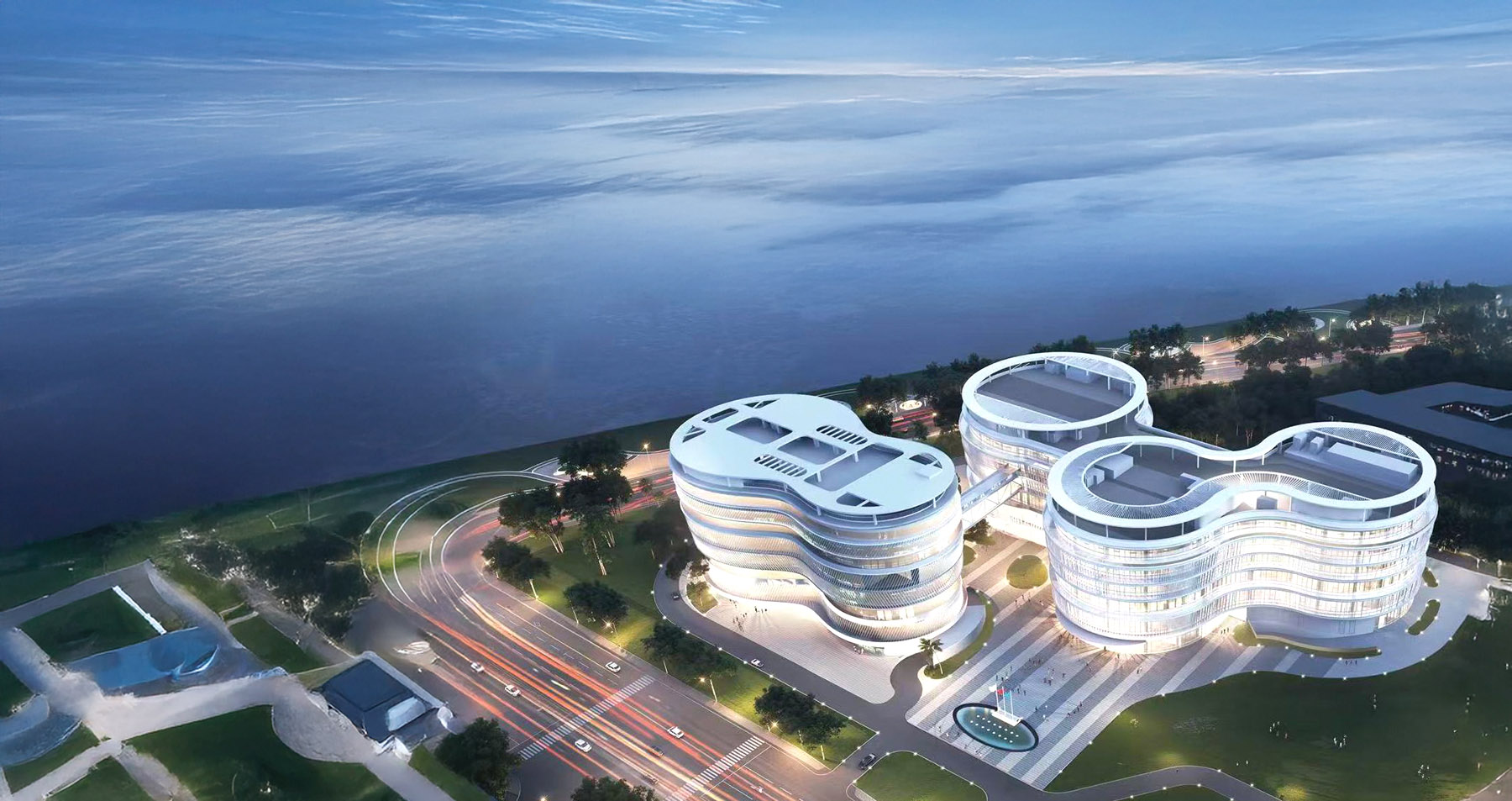The rapid rise of scientific facilities in the Guangdong-Hong Kong-Macao Greater Bay Area is set to drive breakthroughs and open new opportunities for the SARs. Li Bingcun reports.

Editor’s note: In the vibrant Guangdong-Hong Kong-Macao Greater Bay Area, future-oriented innovations are the driving force behind rapid development. This series identifies major scientific breakthroughs and the facilities that support these innovations, with the second article focusing on new devices shaping the scientific facility cluster.
Developing new drugs is a protracted battle marred by steep costs, low success rates and extensive animal and clinical trials. The advent of technology, however, has given rise to “digital patients” that can simulate the therapeutic effects of different treatment methods on humans and revolutionize the paradigm of drug research.
The Human Cell Lineage Atlas Facility (HCLAF) in Guangzhou — a new major scientific and technological infrastructure that started construction in March — is dedicated to creating such innovative models by mapping the evolution of cells.
READ MORE: High-quality development forums to aid modern industry progress in Guangdong
The project heralds the rise of a new generation of cutting-edge scientific facilities in the Guangdong-Hong Kong-Macao Greater Bay Area. New tech infrastructures are cashing in on the artificial intelligence boom, local industrial strengths and the foundation of existing facilities in partnership with Hong Kong and Macao.
Guangdong province has already set up or is building more than 10 large national scientific facilities in fields like energy, materials, and life sciences, accounting for about one-third of the country’s total. Several new projects are also in the pipeline.
The progress made with multiple new devices is set to expedite the rise of a world-leading scientific equipment cluster in the Greater Bay Area that will enhance the region’s research framework and provide greater support for groundbreaking scientific discoveries in the next few decades.

Embracing digitalization
Nestled on Guangzhou International Bio Island, the HCLAF is due to be completed within four-and-a-half years. It aims to compile a detailed cell lineage for life through the digitalization of organs and tissues.
Within the facility, slices of various tissue samples will be analyzed with instruments deployed on production lines, generating data that will ultimately converge into digital models of human body systems for respiratory, circulation and immunity functions.
With breakthroughs in AI technology, biomedicine is rapidly transitioning into the digital age, says Sun Fei, project head and deputy director of the Guangzhou Institute of Biomedicine and Health under the Chinese Academy of Sciences which operates the facility.
Traditional drug development is typically fraught with challenges, requiring billion-dollar investments and a decade-long timeline, but with a success rate of less than 10 percent, according to Sun.
The new testing approach based on digital space will significantly boost efficiency, with the potential to reduce the period of drug development by half. By combining human blood samples, more personalized models can be developed to diagnose diseases and predict their progression.
Organizations and companies will be able to start using the facility’s data for analysis after the first production line rolls out late next year, without having to await its full operation by 2029.
Due to advanced technologies, over 85 percent of HCLAF’s equipment will be independently developed by the institute, presenting a challenge. In future, all innovative achievements, including reagents, instruments and software, will be shared with the community to drive technological transformation.
Meanwhile, another new facility will help scientists conduct experiments in the ocean, and supplements the nation’s infrastructure for carrying out deep-sea scientific research. Construction of it kicked off in February and is expected to be completed in five years. Developed by the South China Sea Institute of Oceanology under the Chinese Academy of Sciences, it’s the world’s first major scientific facility dedicated to deep-sea ecology, specifically focusing on cold seep environments where submarine fluids seep out from the ocean floor.
Such environments are unique deep-sea life oases, major sources of greenhouse gases, and key indicators of combustible ice — a promising green energy source for the future.
Most of China’s cold seep regions are concentrated in the South China Sea. They hold substantial importance for growing marine resources, unraveling the mystery of life evolution under extreme conditions, and controlling climate change.
With devices to be distributed across land, the ocean surface and seabed, the set of equipment will involve a submarine-shaped laboratory that can descend to 2,000 meters below sea level, carrying six scientists to conduct experiments there for up to 30 days.
According to the institute, researches of cold seep had previously relied heavily on brief scientific expeditions like capturing “snapshots” of different aspects of the ecosystems. With the latest facility, scientists can constantly monitor the areas for up to a month, like producing a “movie” that documents their biological activity, fluid dynamics and environmental changes.

Researchers can also perform on-site experiments with deep-sea organisms and other materials, obtaining the most authentic and original data.
The facility’s unique focus on deep-sea research will help optimize the configuration of large scientific facilities in the Greater Bay Area and improve the region’s overall technological infrastructure. It is also set to propel the advancement of marine technologies, supporting the nation’s carbon reduction goals and building a modernized economy where both land and marine industries thrive, according to the institute.
To support scientists delving deeper into the microscopic world, the Greater Bay Area is also establishing a cluster of world-leading light source instruments.
In Dongguan, construction of the world’s second and Asia’s first advanced attosecond — a unit of time equal to one quintillionth of a second — laser infrastructure began in January. In Shenzhen, feasibility studies on building a superconducting soft-X-ray free electron laser, led by the Southern University of Science and Technology, went ahead last year.
Near the China Spallation Neutron Source in Dongguan, the Southern Advanced Photon Source will be set up in collaboration with the neutron source, six universities from Hong Kong and two universities from Macao.
With sound global capabilities, these facilities will offer various perspectives and methods for researchers to gain clearer insights into the composition and evolution of material structures, which is of vital importance for the advancement of fundamental disciplines such as physics, chemistry, materials science, information technology and biomedicine.
Such planning is in line with international trends and brings great convenience to users, says Zhang Junrong, deputy director of the Neutron Science Division of Dongguan campus research branch under the Chinese Academy of Sciences’ Institute of High Energy Physics which runs the neutron source.
Many materials require different light source facilities for comprehensive analysis. For users with urgent needs, it’s crucial to complete the entire experiment within the Greater Bay Area, eliminating the need to wait for equipment at other locations. Besides, some samples are unsuitable for transport as it may alter their properties, says Zhang.
Sun notes that during the 14th Five-Year Plan (2021-25), the nation has planned numerous large scientific facilities in the Greater Bay Area. Currently, technological innovation relies heavily on major scientific platforms. The increasing number and variety of facilities will foster a comparative advantage in research.
These new-generation facilities are beneficial for the South China region by accumulating latecomer advantages in the global tech landscape. Compared to previous ones, the new infrastructure can adopt the latest design and engineering technologies, while leveraging AI to explore new innovation grounds.
Additionally, they will optimize the Greater Bay Area’s overall scientific research landscape by incorporating Guangdong’s local industrial strengths in biomedicine, marine exploration, and electronic information, while increasing the involvement of Hong Kong and Macao in both facility design and application.
With a diversified facility network taking shape in the region, Sun says he hopes that local governments can initiate project-based collaboration among single platforms to further promote their applications.

Fostering collaboration
The deepening ties of major science cities are paving the way for such a vision. Serving as primary hubs of the Greater Bay Area’s large scientific facilities, science cities in Shenzhen’s Guangming district, Dongguan’s Songshan Lake and Guangzhou’s Nansha district have formed strategic partnerships since last year. A new passage that will directly link Songshan Lake and Guangming will shorten the commute to 20 minutes.
Sun Hongzhe, chair professor at the Department of Chemistry of the University of Hong Kong, says large scientific facilities will be key to overcoming the bottlenecks in Hong Kong’s scientific innovation.
Excelling in fundamental research, Hong Kong has significant demand for such equipment. Light source facilities are crucial for research in the city’s advantageous disciplines, while the newly established facilities, such as those for life sciences and deep-sea exploration, may offer future directions for the development of new economies, he says.
Participating in the development of a spectrometer — a device used to separate and measure spectral components of a physical phenomenon — for the China Spallation Neutron Source, Hong Kong has greatly benefited from the facility and nearly all local universities have been using it to carry out related projects.
Sun Hongzhe notes that the joint development model will allow Hong Kong to engage more deeply in equipment design, better serve local users’ needs and provide advantages in usage.
To facilitate Hong Kong users’ access to Chinese mainland facilities, he suggests that a cross-border green channel be created for scientific samples, avoiding mislabeling them as hazardous goods or narcotics.
He also proposes implementing a dual-appointment system to allow Hong Kong researchers to serve simultaneously at the mainland’s large scientific facilities and local universities.
At present, more than half of Nobel Prize achievements, particularly in physics and chemistry, leverage large scientific facilities, whether to validate new ideas, discover scientific breakthroughs, or generate technological innovations.
Amid an intensifying global focus, scientific instruments have become crucial strategic pillars for technological innovation and competition among major scientific powers. Innovation resources are increasingly concentrated on these platforms, significantly enhancing their support for scientific research.
In the future, Zhang says the growth of large scientific devices should adhere to the principle of self-research and development, which is vital for mastering core technologies, and keep enhancing device performance. It’s also essential to focus on improving equipment stability and exploring more energy-efficient technologies to achieve sustainable development.
Calling for institutional innovations, Sun Fei urges the authorities to shift from fully funding designated agencies to using the facilities to introduce social capital, charging agencies for usage and enhancing feedback channels to better serve users with genuine needs.
As for the future planning of the Greater Bay Area’s large scientific facilities, Zhang says upgrading existing facilities and building new ones will be driven by demand, not technology.
“Each industrial upgrade will generate new demands, based on the needs of research, enterprises’ requirements and the country’s strategic needs of core technologies. The innovations we see today may not remain innovative tomorrow. The greatest innovations often emerge in the most unanticipated places — they must be sought in the unknown.”
Contact the writer at bingcun@chinadailyhk.com


